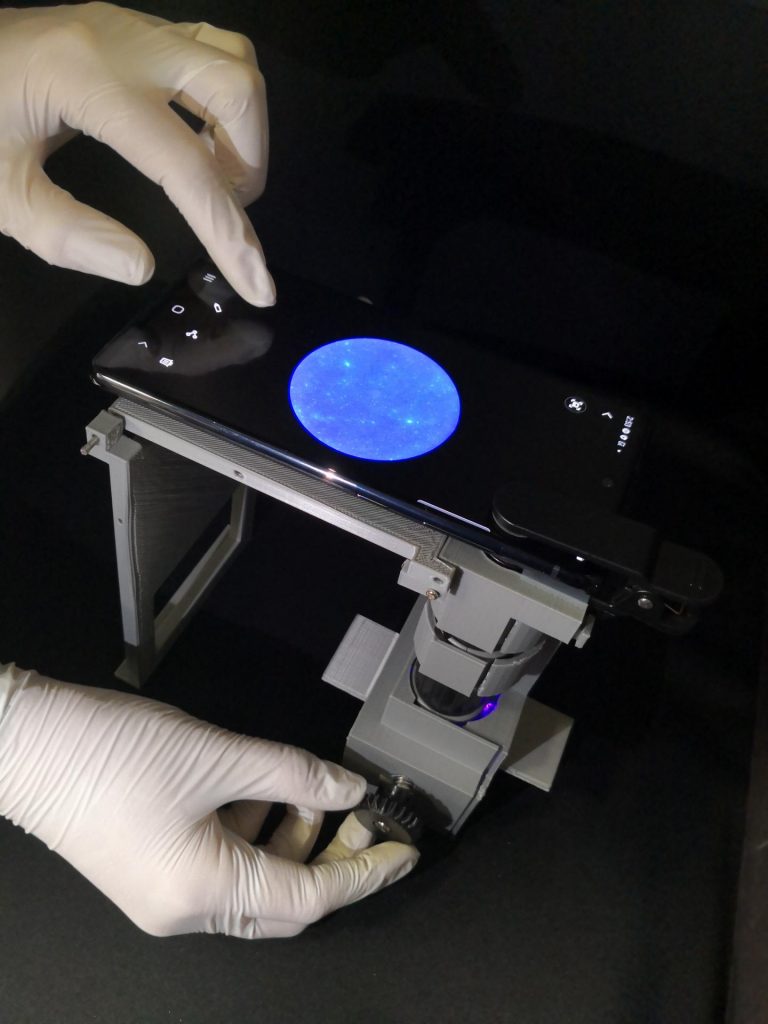
A new COVID-19 test aims to combine the speed of an antigen test with the accuracy of a polymerase chain (PCR) test. The new test consists of a smartphone, a microscope and a piece of microfluidic paper—a wax-coated paper that guides the liquid sample to flow through specific channels. It’s a saliva-based antigen test, but the components cost about $45, anyone who can use a cell phone should be able to use it, and results are available within about 10 minutes.
To create this test, researchers at UArizona are adapting a method they originally created to detect norovirus—the microbe famous for spreading on cruise ships—using a smartphone microscope.
“We’ve outlined it so that other scientists can basically repeat what we did and create a norovirus-detecting device,” said Lane Breshears, a biomedical engineering doctoral student at UArizona. “Our goal is that if you want to adapt it for something else, like we’ve adapted it for COVID-19, that you have all the ingredients you need to basically make your own device.”
The basis of the technology, described in a 2019 paper published in the journal ACS Omega, is relatively simple. Users introduce antibodies with fluorescent beads to a water sample, which can contain saliva. If enough particles of the pathogen are present in the sample, several antibodies attach to each pathogen particle. Under a microscope, the pathogen particles show up as little clumps of fluorescent beads, which the user can then count. The process – adding beads to the sample, soaking a piece of paper in the sample, then taking a smartphone photograph of it under a microscope and counting the beads takes about 10 to 15 minutes. It’s so simple that Yoon says a nonscientist could learn how to do it by watching a brief video.
The team’s latest research using water samples was done in collaboration with Kelly A. Reynolds, chair of the Department of Community, Environment at UArizona. This research was published today in Nature Protocols.
The version of the technology described in the Nature Protocols paper makes further improvements, such as creating a 3D-printed housing for the microscope attachment and microfluidic paper chip. The paper also introduces a method called adaptive thresholding. Previously, researchers set a fixed value for what quantity of pathogen constituted a danger, which limited precision levels. The new version uses artificial intelligence to set the danger threshold and account for environmental differences, such as the type of smartphone and the quality of the paper.
The first over-the-counter, fully at-home diagnostic test for COVID-19 was the Ellume COVID-19 lateral flow antigen test, which detects fragments of proteins of the virus. It was approved in mid-December not long after the agency authorized the first prescriptionCOVID-19 test for home use, and then the first non-prescription test system, where a self-collected sample is sent to a lab for reading. Since the start of the pandemic, the FDA has authorized more than 225 diagnostic tests for the virus, including more than 25 tests that allow for home sample collection.
The UArizona research team was led by biomedical engineering professor Jeong-Yeol Yoon, who is working with a large group of undergraduate and graduate students to develop the smartphone-based COVID-19 detection method.
“I have a couple of friends who had COVID-19 that were super frustrated, because their PCR results were taking six or seven days or they were getting false negatives from rapid antigen tests. But when they got the final PCR tests, they found out they had been sick, like they’d suspected,” said Katie Sosnowski, a biomedical engineering doctoral student who works in Yoon’s lab. “It’s really cool to be working on a detection platform that can get fast results that are also accurate.”













